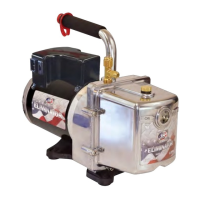7
JB INDUSTRIES • ELIMINATOR OPERATING MANUAL • 800.323.0811 • SALES@JBIND.COM • JBIND.COM
and the less rubbing together. This decrease in friction changes the temperature
around those molecules and the JB digital vacuum gauge is registering those
changes by way of temperature changes at the sensor’s filament. The environment
inside a system being evacuated has more instability at higher micron levels (9000
to 1000) than at lower micron levels (700 to 50). This is evidenced when testing
JB digital vacuum gauges at the different ranges on a secured system. When in the
range of 4000 microns, the gauge display will show 4000 microns, then jump to
4350, then regress to 3875, then jump back to 4000. After being blanked-off at this
level for a period of time, the changing back and forth will level out to changing
from the incremental display of 4000 microns and the next incremental display up
or down of either 4125 or 3875. But, when in a deeper vacuum like 350 microns,
the changes in display on increments may be from 350 to 357 and back down to
350 or even 329 as the environment inside the system becomes more stable and
the time period of these changes will be less as most of the out gassing has been
done. (Figure 17).
Breaking Vacuum
Breaking vacuum prior to shut down is important on larger CFM pumps. This
procedure relieves the stress on the flexible coupler on the next start up. When a
pump is shut down without breaking vacuum, the oil in the cover is pulled back
into the cartridge and intake chamber of the pump trying to fill the vacuum there.
Upon the next start up the pump has to clear the oil out of these areas and all the
stress is on the flexible part of the coupler, especially if the oil is cold. You can see
this occurring by shutting down the pump and watching the sight glass. The oil
will start to drop down and appears as if you are low on oil. Then when you restart
the pump the oil level returns to normal.
To break vacuum on the PLATINUM
®
vacuum pumps, simply close the isolation
valve with the pump still running and open the gas ballast valve all the way and
allow the pump to run 2-3 seconds with the gas ballast valve opened and then shut
pump off and close the valve.
To break vacuum on the Eliminator vacuum pumps. After blanking off at the
manifold or an external isolation valve, if used, crack open the unused intake port
on the pump and allow to run 2-3 seconds and shut pump off.
CROSS REFERENCE OF
VACUUM MEASUREMENTS
Boiling temperature of water at converted pressures (Figure 18).
TEMP. F° MICRONS
INCHES OF HG
VACUUM
PRESSURE POUNDS
SQ. IN.
212 759,968 0.00 14.696
205 535,000 4.92 12.279
194 525,526 9.23 10.162
176 355,092 15.94 6.866
158 233,680 20.72 4.519
140 149,352 24.04 2.888
122 92,456 26.28 1.788
104 55,118 27.75 1.066
86 31,750 28.67 0.614
80 25,400 28.92 0.491
76 22,860 29.02 0.442
72 20,320 29.12 0.393
69 17,780 29.22 0.344
64 15,240 29.32 0.295
59 12,700 29.42 0.246
53 10,160 29.52 0.196
45 7,620 29.62 0.147
32 4,572 29.74 0.088
21 2,540 29.82 0.049
6 1,270 29.87 0.0245
-24 254 29.91 0.0049
-35 127 29.915 0.00245
-60 25.4 29.919 0.00049
-70 12.7 29.9195 0.00024
-90 2.5 29.9199 0.00005
--- 0.00 29.92 0.00000
MEASURING VACUUM IN
MICRONS OR INCHES?
Figure 17
Figure 18

